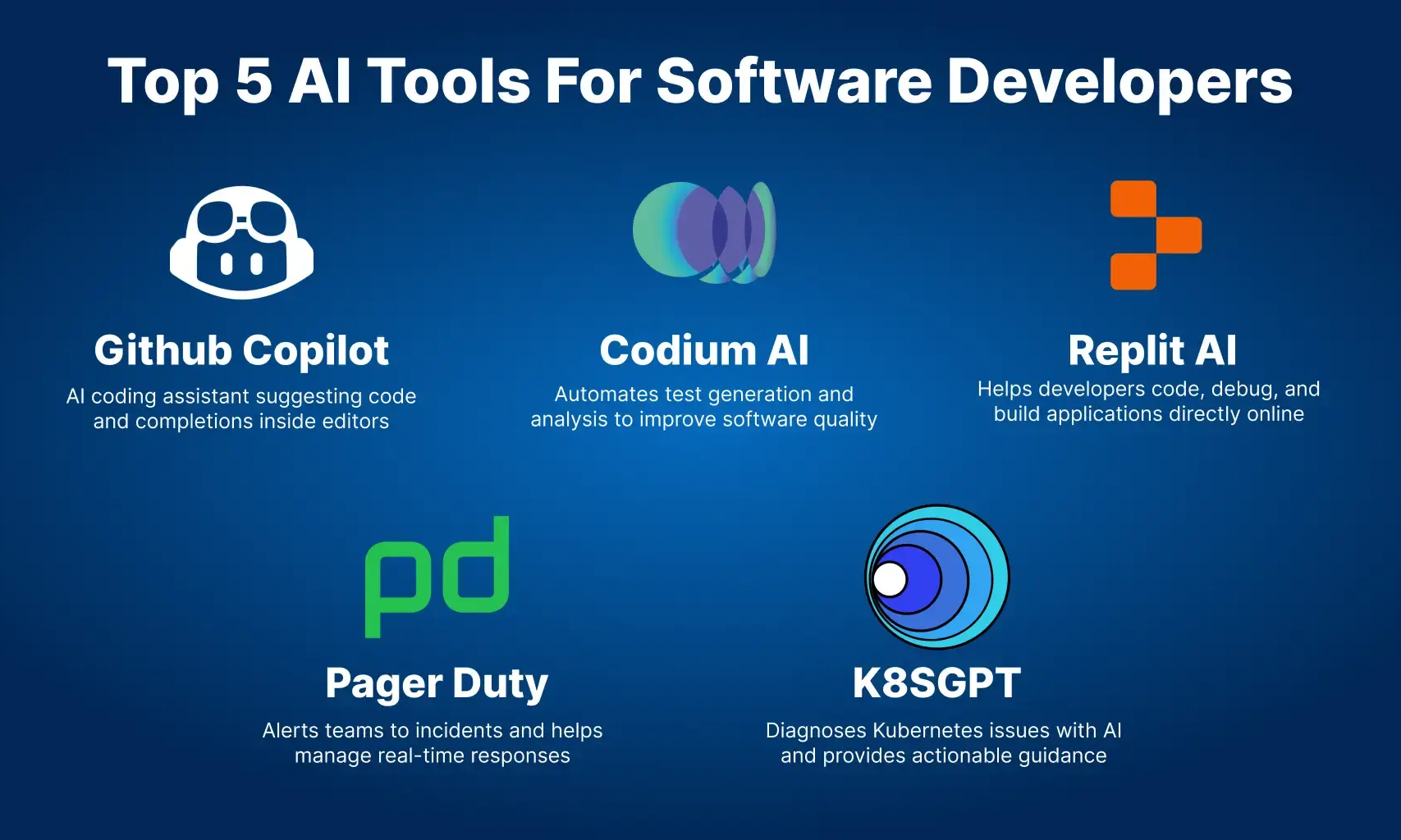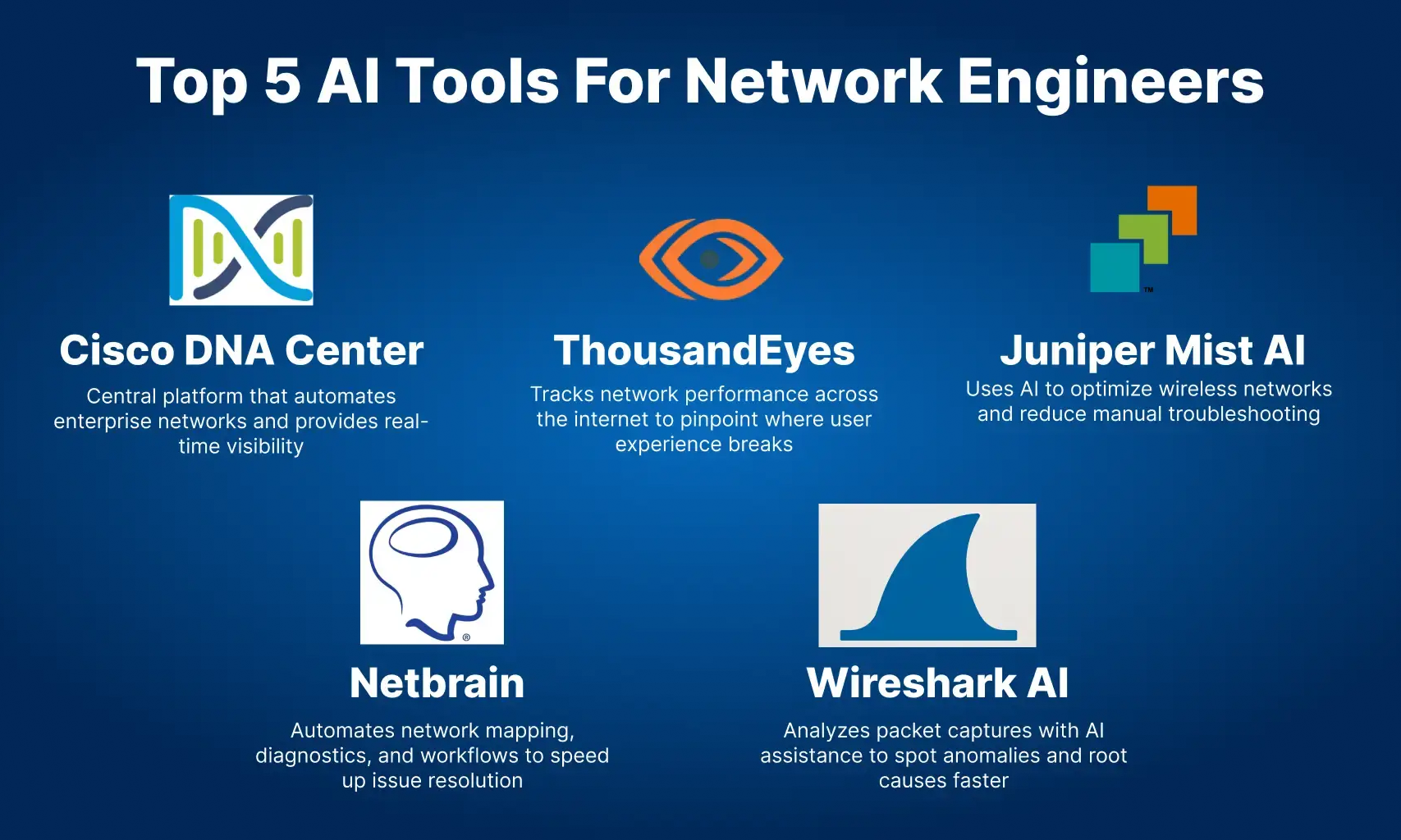Learning about AI today can feel like walking into the world’s biggest library. Every shelf is stacked with new tools, algorithms, and courses which means endless knowledge waiting to be discovered. But without knowing which sources can actually help you upskill, you can get lost wandering the aisles.
The real challenge for engineers is knowing which tools actually matter and which blogs and platforms will sharpen your expertise rather than add to the noise.
That’s where trusted sources become essential. Instead of chasing every new release, following the right AI blogs can act like a personal guide. These insights point you to detailed insights, practical tutorials, and updates that actually have a significant impact on your career.
How to Use AI Tools to Boost Your Career in 2026?
AI does not have to be something you fear because it can become your strongest career ally when used correctly. Professionals who use AI tools and agents effectively solve problems faster and make better decisions.
The most important thing is to treat AI as a teammate, not a competitor. Experiment with it, integrate it into your daily work, and focus on tools that complement your strengths. By doing this, you can become a professional who stands out in a dynamic job market.
Top Tech Careers and How to Upskill with AI?
AI is changing the tech world, opening doors for those who know how to use it well. By learning the right AI tools and skills, you can boost your career and stay ahead of the competition.
Let’s dive into each tech career and see which skills and AI tools can help you succeed.
1. Software Engineering
Software engineering remains one of the most in-demand tech careers, but the role is evolving rapidly with AI integration. Today, developers are expected to write clean code, design scalable systems, collaborate with AI-powered tools, and leverage automation to increase efficiency.
Current Trends in Software Engineering Jobs
- AI-assisted development
Tools like GitHub Copilot and ChatGPT are increasingly used for code generation, debugging, and documentation. - Full-stack and cloud expertise
Companies are seeking engineers who can handle both front-end and back-end development, often in cloud environments. - DevOps and CI/CD integration
Knowledge of automated deployment pipelines is becoming standard. Focus on collaboration and efficiency
AI is helping teams streamline workflows and maintain code quality across large projects.
Top 5 AI Tool Combos for Software Engineers
- GitHub Copilot + CodiumAI + ChatGPT
Write, refactor, and test code seamlessly. Copilot handles boilerplate, CodiumAI generates test cases, and ChatGPT explains/debugs logic. - Replit AI + Hugging Face + LangChain
Build end-to-end AI-powered apps directly from your editor, integrate NLP features, and connect models into workflows. - Notion AI + Swimm + GitHub Copilot
Auto-generate project documentation, summarize notes, and keep dev knowledge clean and searchable. - Jenkins (AI plugins) + Harness.io + PagerDuty AIOps
Smarter CI/CD pipelines with predictive failure alerts and AI-assisted deployment rollbacks. - Kubernetes + K8sGPT + Terraform + Infracost
Manage infra at scale with AI debugging, cost estimation, and automated infra-as-code.

2. Data Scientist
Data Science has always been about turning raw data into actionable insights, but the field has exploded with AI. Companies nowadays want predictive models, intelligent analytics, and AI-driven decision-making. That’s why today’s data scientists are expected to be part analyst, part engineer, and part AI researcher.
Current Job Trends in Data Science
- Shift from BI to AI-first analytics
Companies prefer predictive models over static dashboards. - Generative AI in analytics
Tools like ChatGPT for querying data directly in natural language. - MLOps skills in demand
Employers seek people who can take ML models to production, not just notebooks. Cross-functional collaboration
Data scientists are expected to work with software engineers, ML engineers, and product teams.
Top 5 AI Tool Combos for Data Scientists
- Python + scikit-learn + Jupyter Notebook
The classic combo for data preprocessing, EDA (exploratory data analysis), and building baseline ML models. - TensorFlow + PyTorch + Hugging Face
Power stack for deep learning, NLP, and generative AI projects. - SQL + dbt + Snowflake (with AI plugins)
For scalable data pipelines and AI-assisted querying at enterprise level. - LangChain + Pinecone + OpenAI APIs
Build LLM-powered analytics apps, recommendation systems, or semantic search engines. - Tableau + Power BI + ThoughtSpot (AI-powered BI tools)
Automate dashboards, generate insights from data, and enable natural language querying.
3. Cloud Engineer
Cloud Engineers are the backbone of modern tech companies, ensuring applications scale, stay secure, and run smoothly. With AI adoption accelerating, cloud roles are shifting from simply managing infrastructure to designing AI-ready environments where machine learning models, APIs, and large datasets can thrive.
Current Job Trends in Cloud Engineering
- AI-first infrastructure
Companies want cloud setups optimized for AI workloads (e.g., GPUs, vector DBs, and serverless architectures). - Hybrid and multi-cloud expertise
Demand for engineers skilled in AWS, Azure, and GCP. - AI-driven monitoring and observability
Predictive scaling and automated incident resolution with AIOps. Infrastructure as Code (IaC)
Terraform, Pulumi, and AI-enhanced automation tools are becoming standard.
Top 5 AI Tool Combos for Cloud Engineers
- AWS CodeWhisperer + SageMaker + CloudFormation
Build AI apps, deploy ML models, and automate infrastructure seamlessly. - Azure OpenAI Service + Azure ML Studio + Azure DevOps
Microsoft’s integrated stack for deploying, monitoring, and scaling AI solutions. - GCP Vertex AI + BigQuery + AutoML
A Google-native combo for training models, analyzing large datasets, and automating ML. - Kubernetes + K8sGPT + Prometheus/Grafana
Manage clusters smarter with AI-based debugging and predictive monitoring.

4. Cybersecurity Engineer
Cybersecurity has always been a high-stakes career, but AI is rewriting the rules. Threats are evolving faster than ever, with AI being used to craft phishing attacks, crack passwords, and probe networks.
At the same time, AI-powered defenses are helping security teams detect anomalies, predict attacks, and respond in real time. Cybersecurity engineers today must learn to wield AI as both a shield and a sword.
Current Job Trends in Cybersecurity
- AI-powered threats
Deepfakes, automated phishing, and adversarial ML attacks are on the rise. - Zero Trust Architecture adoption
More companies are moving away from perimeter-based security. - AI-driven SOC (Security Operations Center)
Security teams are using AI to automate incident detection and response. - Cloud security focus
With hybrid work and AI workloads, cloud-first security expertise is in high demand.
Top 5 AI Tool Combos for Cybersecurity Engineers
- Darktrace + Splunk AI + CrowdStrike Falcon
AI-driven anomaly detection, real-time monitoring, and endpoint protection. - Palo Alto Cortex XSOAR + IBM QRadar + ChatGPT
Automate incident response workflows, integrate logs, and speed up triage with AI assistance. - Microsoft Sentinel (AI SIEM) + Defender ATP + Azure OpenAI
End-to-end intelligent threat detection and automated remediation. - Hugging Face Transformers + LangChain + Malicious Dataset Libraries
Build and test custom AI models for threat detection, phishing analysis, and malware classification. Tenable Nessus + Rapid7 InsightVM + AI Vulnerability Prioritization
Smarter vulnerability scanning, patch prioritization, and automated reporting.

5. Network Engineer
Network engineers are the architects of digital connectivity, ensuring data flows seamlessly across systems. With the rise of AI, networks are becoming self-healing, adaptive, and intelligent. AI is being used to predict outages, optimize bandwidth, and secure networks in real time.
Current Job Trends in Network Engineering
- AI-driven monitoring
Predictive analytics to detect network anomalies before downtime. - 5G & Edge computing
Growing demand for low-latency AI-powered networks. - Software-Defined Networking (SDN)
Automating network management with AI controllers. Security-first networking
Integration of AI to spot intrusion attempts instantly.
Top 5 AI Tool Combos for Network Engineers
- Cisco DNA Center + ThousandEyes + AI Anomaly Detection
Automates and monitors enterprise networks with AI-driven visibility and real-time anomaly detection. - Juniper Mist AI + ServiceNow + Splunk AI
Combines AI-based wireless optimization, automated IT workflows, and intelligent log analytics for proactive issue resolution. - NetBrain + SolarWinds AI Ops + PagerDuty
AI-powered network automation and monitoring with incident escalation for faster troubleshooting. - Kentik AI + Prometheus + Grafana AI Plugins
End-to-end network observability with AI-assisted metrics, alerts, and intelligent visualization. GNS3 + Wireshark AI + ChatGPT
AI-enhanced lab simulations, packet analysis, and natural language troubleshooting for network engineers.
6. Product Management
In today’s market, great products don’t just solve problems; they solve them smarter with AI. That’s why product managers (PMs) who understand how to integrate AI into roadmaps are in demand across industries.
Whether it is designing features powered by recommendation engines, improving user personalization, or driving business insights from data, AI-savvy PMs are the ones shaping the next generation of products.
Current Job Trends in Product Management
- AI-first product strategy
Companies increasingly expect PMs to design with AI at the core, not as an add-on. - Data-driven decision-making
PMs are leveraging analytics and ML-driven insights to guide feature priorities. - Cross-functional leadership
Demand for PMs who can bridge conversations between engineers, designers, and data scientists. - AI-powered user research
Using sentiment analysis, heatmaps, and AI-based surveys to understand users better. Ethical AI oversight
PMs ensure products align with privacy, fairness, and responsible AI principles.
Top 5 AI Tool Combos for Product Managers
- ChatGPT + Miro + Notion AI
For brainstorming, roadmap planning, and creating product specs faster. - Tableau + Power BI + Google BigQuery ML
To analyze user behavior and make data-driven product decisions. - Figma + Uizard + MidJourney
AI-assisted prototyping, UX design, and mockup creation. - Amplitude + Mixpanel + ChatGPT Plugins
AI-driven product analytics for measuring feature adoption and user retention. Jira + Linear + GitHub Copilot (integrations)
Smarter sprint planning and better communication with engineering teams.
7. UI/UX Designer
Design is no longer just about making things look good, it’s about creating experiences that feel natural, intuitive, and even predictive. With AI, designers are moving beyond static wireframes into adaptive and personalized interfaces.
Current Job Trends in UI/UX Design
- AI-driven design tools
Faster prototyping and automated wireframes. - Personalized experiences
Using AI to tailor interfaces for different user segments. - Voice & multimodal design
Demand for designers who can craft experiences for voice, AR/VR, and AI assistants. - Accessibility focus
AI-powered testing to make products inclusive for everyone. Generative design
Designers leveraging AI to explore creative directions at scale.
Top 5 AI Tool Combos for UI/UX Designers
- Figma + Uizard + Galileo AI
Turn text prompts into mockups and iterate designs in minutes. - MidJourney + DALL·E 3 + Runway ML
Generate stunning visuals, graphics, and UI assets for faster creative exploration. - Maze + User Testing + Hotjar AI
Automate user research, feedback analysis, and usability testing. - Adobe Firefly + Photoshop AI + After Effects AI
AI-powered creative workflows for graphics, branding, and animations. - Stark + Axe AI + ChatGPT
Accessibility audits, color contrast fixes, and AI-assisted design documentation.

Final Thoughts
AI is already changing the way we work and it is only going to keep evolving. From software engineering to product management to UX design, AI is reshaping the roles we play, not by replacing us, but by making us more efficient.
The key to thriving in this new world is simple:
- Stay curious and keep learning,
- Master the right AI tools for their field,
Treat AI as a collaborator, not a competitor.
To truly make AI work for you, you need right people and support, that’s where we come in. With over a decade of experience, we have helped more than 100 businesses unlock AI’s full potential with our AI development services.
What makes us different? We solve real problems by focusing on delivering measurable results that help you grow faster.
If you need AI solutions or are looking for AI developers to extend your internal team, we’re here to help.
Reach out today, and let’s talk about how we can make AI work for your business.

